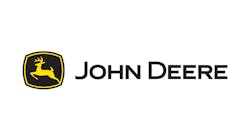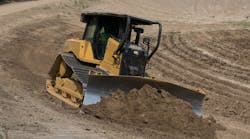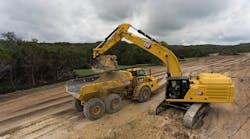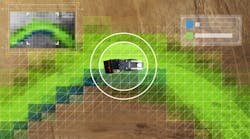From commercial buildings to manufacturing warehouses, water treatment facilities to packing plants, Diamondback Concrete Construction, based in Fort Morgan, Colo., is best known for its ability to lay out and pour very large projects with speed and precision.
This reputation has helped the commercial construction company grow from a small four-man startup less than a decade ago into a leading regional contractor with a 10-man crew and well over $3.5 million in annual revenue. Much of this change can be attributed to the company's dynamic owner, Bill Bordovsky, and his persistent search for tools and techniques that can streamline — and grow — his operations.
Bordovsky confirms, "I'm a turnkey concrete contractor; that means my clients expect speed and accuracy on every job. Equipment is a big part of our ability to provide consistent quality performance, and a big reason why we've replaced our conventional tapes and levels with digital measuring instruments in many applications. Digital measuring instruments have literally revolutionized the way I work, introducing unprecedented efficiencies and collapsed cycle times on construction layouts of all sizes."
Today, Diamondback Concrete Construction is using this capability and a highly skilled crew to expand its portfolio, providing start-to-finish expertise on all concrete work from the structural foundation to sitework, and finishing with the curb and gutter forming.
The Digital DivideFirst formed in 1999, Diamondback Concrete Construction has emerged has one of the leading concrete contractors serving commercial clients in Colorado and surrounding states. For instance, the firm has an exclusive contract to support all concrete needs to a major energy company, as well as major clients in wastewater and water treatment, beef packing, and other commercial and industrial work.
At the outset of every project, Bordovsky relies on his Leica Geosystems Builder R200M professional layout instrument. Designed for builders, this combination theodolite and electronic distance measuring (EDM) device speaks the contractor's language, supporting the five capabilities a formwork builder cares about most: linear length, plumb, square, level, and slope measurements. The Leica Builder relies on a precise EDM and flat prism to measure distances up to 250 meters.
"In one step, I can locate points for a reference line as well as control design elevations and measure angles," explains Bordovsky. "In addition, the onboard computer stores points from construction plans, saves as-built measurements and other site survey data for transfer to a PC. With this instrument, construction layout becomes an expedited one- or two-man job."
For instance, on a typical formwork layout, Bordovsky uses the instrument to lay out footings and foundation walls with greater accuracy, eliminating the common errors that can occur when attempting to transfer surface points into an excavated foundation hole using conventional stringlines, tapes and levels.
Conventional project layout methods require batter board setups that run stringlines for a foundation, squaring grid lines, determine point positions, and so forth. Naturally, the string and batter board method introduces string line errors associated with tugging on the string and tape sag. The stringlines also create potential tripping hazards on the job site and are often knocked out of position by other tradesmen on the project site.
Bordovsky adds, "Measuring tapes sag, string lines bow and levels are difficult to control over 10-foot depths. The errors that are associated with these conventional tools are virtually non-existent with the Builder. I can position all of the job control points from a single setup location, out of harm's way, independent of string lines, tapes and levels."
Providing accuracies in the sub 1/8-inch range at 200 feet, the measuring device streamlines the layout process and virtually eliminates human induced, conventional layout errors. The time savings are instantly evident.
On the JobIn a recent project, Diamondback Concrete was contracted to lay out and pour a 35,000-square-foot beef packing plant that included a 500-linear-foot serpentine wall to run the cattle.
In many cases, the project's general contractor might call a surveyor to locate property pin positions. Naturally, once the excavation teams moves through, those pins are torn out and the surveying team is called in again to relocate the pins prior to preparing the foundation.
On a project like the beef packing plant, Bordovsky relies on his survey tool to handle the entire process quickly and easily. Using the Leica Builder's EDM, he sets the property pin positions and stores the position for future use within the Builder's onboard computer.
"We were ready to start forming the foundation for this project in a couple of hours," recalls Bordovsky. "Normally this entire process would require a minimum of a week because we'd have had to wait for the survey firm to come to the job site. I can do it while prepping the rest of the project for excavation and pour. It's efficient for me, my crews, the general contractor, and the client."
All pins were ultimately located to within 1/16-inch across the entire 35,000-square-foot site.
Once the excavation was complete, Bordovsky or one of his team went back and set up on existing points parallel or perpendicular to the job site, from 10 feet to 500 feet away from the project.
With the offsets recorded in the Builder's computer, the system can automatically locate the corner points of the building. Once the building pad is prepared, Bordovsky uses the measuring tool much like a transit to shoot anchor bolts, wall lines and rebar along the control lines.
The benefits of digital measuring systems in a builder's toolbox become particularly clear when working a project with arcs, such as water storage tanks. Normally, the layout of a circular structure requires a professional surveying crew as it's very difficult to complete accurately with conventional tape and level methods. Bordovsky simply imports the blueprint arc information into the digital measurement tool which instantly converts data to appropriate measurements and calculates circumferences inside and out, all the preparation necessary to allow him to shoot center points, anchor points and anything else required to build that structure.
Overall, Diamondback Concrete's shift to the digital measuring has helped it expand services and grow its business.
Bordovsky concludes, "Clients come to my company looking for sitework and building layout. Now I'm able to take a little more responsibility throughout the project, and make the overall project headache-free for the general contractor. Since my business is built on repeat customers, I'm focused on doing it right the first time, so that I don't have to make repairs or fix errors. With easy, fast and reliable digital measuring devices, I'm just that much more confident."




